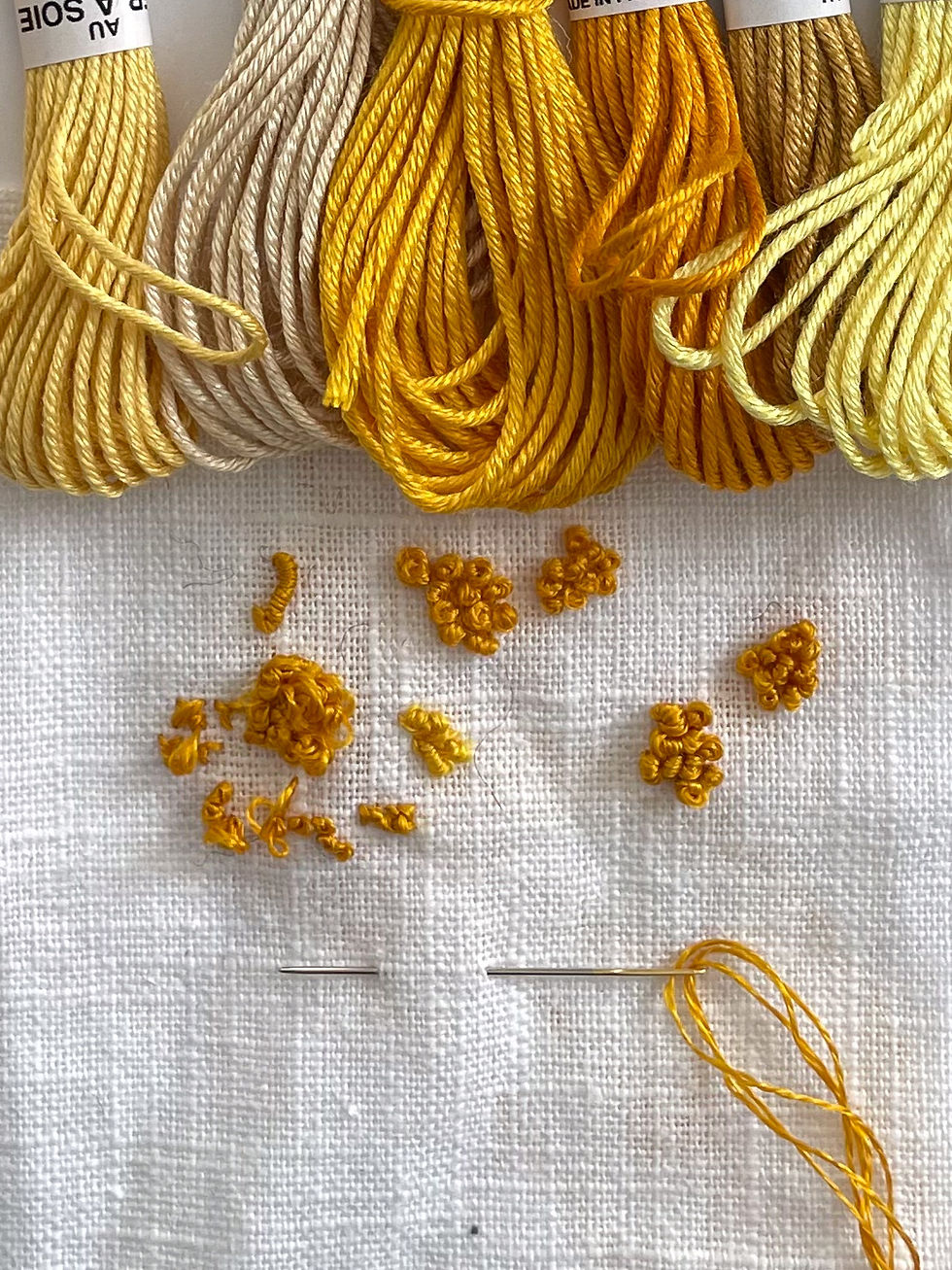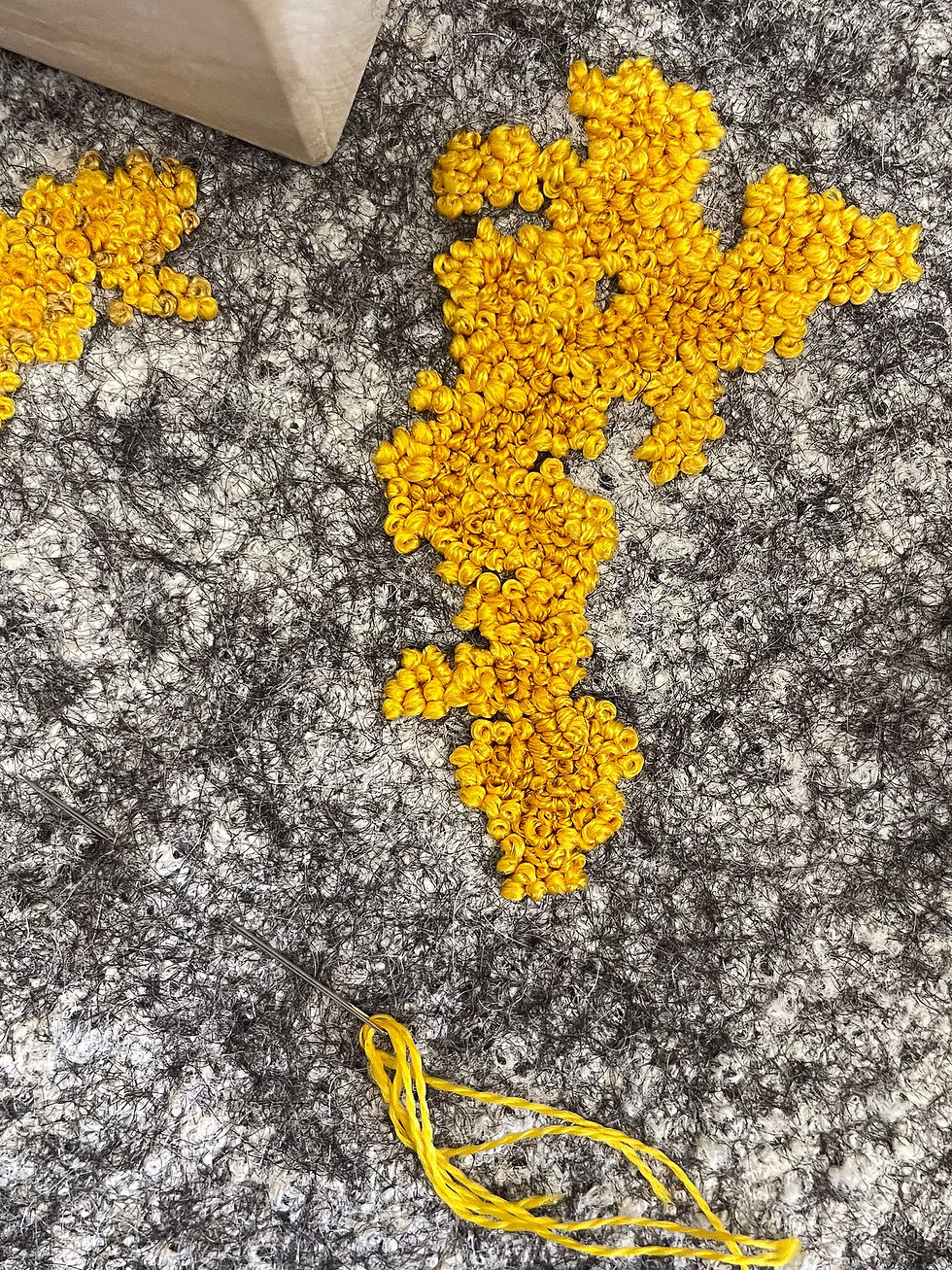yellow lichen on granite. or: the parts of the process that usually stay hidden
- anjarlampert
- May 26, 2024
- 6 min read
gabi brandhuber, owner of textilportal and made with blümchen, as well as organiser of stoffspielereien, extenden an invitation to this months's stoffspielreien with the topic of "textures inspired by nature". she had seen my embroidered sunburst lichen last year, which i have blogged about already here.

i already had blogged about this piece of work, so i was wondering about what more to add to it without repeating myself.
the answer came to me in one of my last embroidery classes for beginners during a conversation about samplers (or material tests, mock ups, or whatever you want to call them) and why samplers are so useful. during the conversation it dawned on me that when looking at a finished piece of embroidery much of the same thing happens in many viewers that also happens other craft or arts contexts, which is that people come to the wrong conclusion that the piece emerges out of thin air, just like that. and this makes total sense, because most of the time most of the process stays hidden for the viewer.
in this particular case, there was this notion that i came up with the idea, got some threads and started stitching the sunburst lichen. when i started explaining how for this piece i did quite a lot of tests with different kinds of thread and many varieties or french knots, before i knew which combination of thread and french knots was the one that worked best, i could feel a light bulb moment and a sense of relief in most of the workshop participants. they had just assumed doing tests with threads and testing stitches before working on a project was something only beginners need or a sign of not being able to "properly embroider".
that's why i'm sharing a bit about my process for this piece of embroidery to clarify that there is no "magic" to it, but a lot of research, tests, sampling, ... before starting the actual embroidery, and that this is a very common thing to happen in craft and art, no matter how experienced or unexperienced you are. printers do test prints to test their plates, most of the photographs taken never make it to exhibitions or books or customers, you do test shots to check for the light and other factors, you do rehearsals or run-throughs in opera houses and theatres, there material tests, ... the list goes on and on. the idea of coming up with an idea, grabbing your materials and then you just make the finished thing is very unrealistic. sure, it happens, but a lot of the time it doesn't. usually there are many steps before and in the middle of a project, there are outtakes, tests, experiments, samples, fails, throw-outs, things that tun out completely differently than you imagined. as unrealistic is the notion that with growing experience you won't need any testing any more. of course you gain knowledge about materials and tools and their behaviour, but you still can be wrong and unsure about things and you will keep testing and trying things beforehand. and even with tests and experiments you can still go wrong.
with the sunburst lichen i knew (this as well didn't come out of thin air, but i'll maybe write about this part of the process another time) i'd use a piece of felt to stitch on that i had made a few months prior and that looked a lot like dark granite. so that part was already decided. the photo that inspired the piece is this one:

my goal was not to replicate this exact specimen, i wanted to stitch a more general character of lichen in this place. to make this happen i looked at many lichen and took many photos. i read about lichen, their anatomy and how they live, bought a lichen guidebook to look a lichen that are uncommon to my area. while doing research like this, your perspective changes, you start noticing lichen everywhere, my eyes were and still are quite trained to discover lichen everywhere.
sunburst lichen come in all shades of yellow and green depending on the exposure to sun:




people approached me on the street wanting to know what i was doing crouching around between trees and parked cars, which ended up being a really nice conversation about trees in vienna, the vienna tree register (you can look up the trees in vienna either by their number or via location) and if lichen are a good or bad sign (answer: it depends).
this for sure is a very invisble part of my process that can take really long (at least for me) – research, immersing myself into a topic until the project has taken up form and fermented long enough to finally being able to start the visible parts of working on it.
my inspiration was a very intensely yellow specimen, so i knew i would be picking brightly yellow colours for my threads rather than the greenish or whiteish ones.
working with a colour chart i picked yellow, brown and beige varieties of soie d'alger silk embroidery threads, as well as some vintage silk threads in yellow shades from my collection.
the next step was to split the threads into different thicknesses (the vintage thread was also a stranded thread) and doing test versions of french knots with varying numbers of wraps. in a perfect world i would have tested on felt, but as the felt i had made was a one-off, i did the thread and stitch tests on a cotton fabric. i wanted to find out which combination of thread, number of strands and size and tightness of french knots would look the most like a sunburst lichen surface. here is a work in progress image of the sampler at some point in the middle of my test – there were more knots in the end:


in the zoomed in photo you can probably see that there are several versions of french knots; smaller and larger ones (with more or less wraps), tight and loose ones, and even some looking more like tiny caterpillars where i wanted to test the extremes of wraps and what that would look like. what you probably also can see in the vintage thread on the left side that it's a thread of the capricious kind, it's very, very needy and wants to have lots of attention while working with it, otherwise it tangles up with every third stitch. that was also good to know beforehand.
after all the tests i knew my preferred results would be with using both soie d'alger and the vintage silk thread two-stranded and doing three wraps for the french knots.
only now was i ready to start working on the actual embroidery project, and even then there were experimental parts – how densely do i need to embroidery the french knots on the felt surface, how to do the colour grades so they look natural, how to shape the lichen parts, ... that's the part where you only can keep going and make decisions while making. sometimes that comes very natural and sometimes it's very stressful.
here is another work in progress picture – i clamped the felt to the table with wooden clamps to be able to use both my hands for embroidering, which was very much needed especially with the vintage thread. it worked really well with the felt being quite stiff.

here's the backside aka guts of the lichen embroidery:

what's my point with all of this? samples or material tests are a natural part of my work and i find them extremely helpful. if only to get my fingers and hands into a rhythm so i can then work more smoothly on a project. i also find that you get to know materials and tools very in depth when you try them out in different settings and variations, sometimes just for experiment's sake. over time you also accumulate a kind of collection of projects and techniques you can refer back to (if you remember where you put them – as of now my sunburst lichen is missing; it can't be far, but i can't remember where i put it.).
it also goes to show that the parts where things get messy, undone, not quite right, etc. are an integral part of a project. these are the experiments you make to find out what does work and what doesn't. and to find out what doesn't work, the "doesn't work part" needs to happen at some point. and a sampler is a perfect place for that.
I thoroughly enjoyed this post and reading about every stage of your process for this project. I love that it even inspired conversations about lichen on the streets of Vienna- what a wonderful service you are doing to the world of textiles to share such detail of your experience 💛
I have a lot of respect for your thoughtful, organized approach to art making.